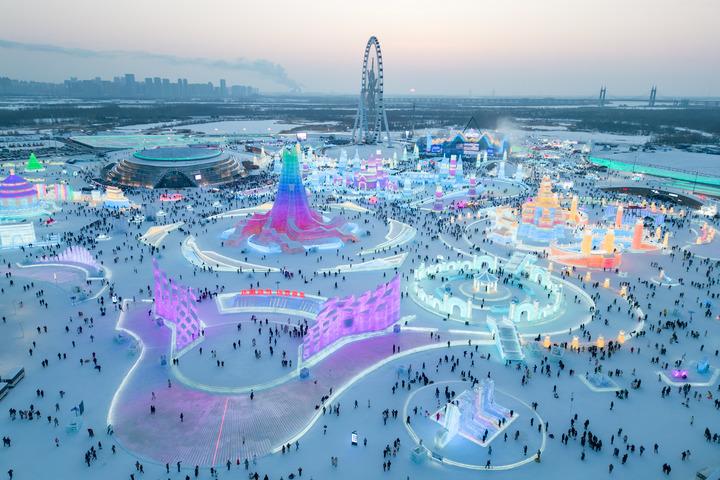BEIJING, Jan. 11 (Xinhua) -- As darkness descends and the streetlights illuminate the surroundings, the streets become packed with people. Foreign businessmen and tourists from afar leisurely wander among the glorious ice sculptures and snow statues at Harbin Ice and Snow World, exclaiming in admiration from time to time.

A visitor has fun at the Harbin Ice-Snow World in Harbin, northeast China's Heilongjiang Province, Jan. 5, 2024. (Xinhua/Wang Jianwei)
Harbin, known as the "crown jewel of ice and snow", has become one of China's most sought-after tourist destinations this winter, considerably fueling the country's ice and snow economy. Numerous foreign enterprises are riding this wave, trying to seize the new opportunities the ice and snow economy presents.
Data show that Harbin, the northernmost provincial capital city in China, welcomed nearly 3.05 million tourists and generated a total tourism revenue of 5.914 billion yuan during the three-day 2024 New Year holiday, with both numbers reaching record high.
In Harbin, the influx of tourists who come to experience the northern China city and embrace the coldness is continuing bringing surprises to various industries. Pierre G. Chidiac from France, the general manager of Sofitel Harbin, said the city's hotel business is so busy this winter, with a significant rise in passenger numbers at the airport and train station. He believes Harbin has become one of the most favored tourist destinations in China.
French hospitality group Accor, which owns Sofitel Harbin, boasts a global presence with over 5,100 branded hotels in more than 100 countries and regions. Pierre, who previously worked in Harbin from 2008 to 2011, holds vivid memories of the breathtaking Ice and Snow World and the vibrant Central Street. In May 2023, he returned to Harbin and felt the even stronger economic heart-beat in this familiar and vibrant city.
Pierre mentioned that contemporary travelers seek adventurous experiences, which is why winter activities that offer challenges have increased popularity continuously. Harbin attracts a large number of tourists who not only explore traditional iconic sites such as the Central Street, but also enthusiastically engage in various ice and snow festival celebrations on the Songhua River. They can even go and experience the ski resorts in Yabuli or visit the Snow Town nestled in the mountainous landscapes of Mudanjiang city.
He believes that such winter adventure trips will definitely draw more foreign tourists and businesses to Harbin, thus establishing ice and snow tourism as an important driving force for local economic development.
Dai Bin, the president of the China Tourism Academy, said that the ice and snow tourism related consumption has a spillover effect on driving the growth of local service sectors such as catering, retail, show and performances, transportation, and communications. This has, in turn, promoted investment in scenic spots, resorts, hotels, homestays, and business districts, as well as the research, development, manufacturing, and sales of ice and snow equipment. Dai asserts that ice and snow tourism is becoming a new engine for the local economy.

This aerial photo taken on Jan. 5, 2024 shows visitors having fun at the Harbin Ice-Snow World in Harbin, northeast China's Heilongjiang Province. (Xinhua/Zhang Tao)
Harbin is not alone. At the moment governments at all levels and the general public are both proactively striving to create a favorable business environment for economic development and establish good reputation in order to draw more investment and projects.
The culture and tourism department released maps and guides for tourists. As a safety measure, the underpass has been carpeted to prevent visitors from slipping. City volunteers are offering free ginger tea with brown sugar to visitors. In this winter, Harbin not only experiences a booming ice and snow economy, but also demonstrates its "new image" of urban development to the world.
"From the reindeer on the Central Street to the artificial moon above the Sophia Cathedral, these landscape designs cater to the needs and experiences of tourists, making them feel that their trips are worth every penny and more," said Ye Fei, president and CEO of Michelin China. According to Ye, the construction of a tourism environment that prioritizes consumer needs, along with an improved public service system, are the internal forces driving the success of Harbin's ice and snow economy. Harbin has set a good example in this regard.
Within the 810,000-square-meter area of the 25th Harbin Ice and Snow World, skilled artisans have used 250,000 cubic meters of ice and snow to create a magnificent kingdom of ice and snow art. The park has been emerging as one of the most adored ice and snow tourist attractions in China. Combining elements of ice and snow, light and night, the recently opened 40th China·Harbin International Ice and Snow Festival offers a mesmerizing fusion of sightseeing and entertainment. It creates a passionate, dazzling, and romantic ice and snow carnival for global tourists.
Ye noted that the thriving ice and snow economy in Harbin demonstrates the robust vitality of the Chinese economy, which instills further confidence of foreign investors such as Michelin seeking to establish a foothold in the Chinese market. Michelin provided support for the construction of two ice sculptures at this year's Harbin International Ice and Snow Festival, namely "Temple of Heaven" and "Notre Dame de Paris", exemplifying its efforts to promote dialogue and exchanges of Chinese and French cultures.
Michelin plans to invite and introduce French chefs to China in the future to display their culinary skills. The company will also launch a series of related experiential activities such as food festivals in more Chinese cities. Such initiative aims to provide Chinese consumers access to high-quality French products, such as its agricultural produce and wines, Ye noted. (Edited by Niu Huizhe with Xinhua Silk Road, niuhuizhe@xinhua.org)




 A single purchase
A single purchase









